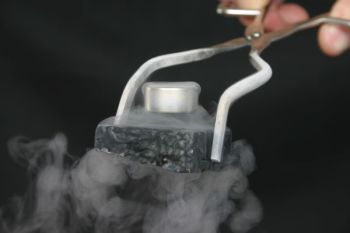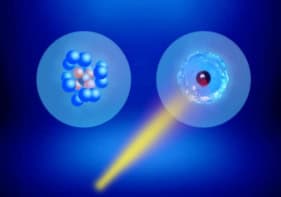
Levitating a magnet using liquid nitrogen. (Credit: Yorick van Boheemen)
By Matin Durrani
Tucked away in the corner of the foyer at the RAI Convention Center in Amsterdam, where the 25th International Conference on Low-Temperature Physics has been taking place for the past week, I found a series of great little demonstrations by a group of students from the University of Leiden.
The students were showing highlights from a roadshow — dubbed “Freezing physics” — that they perform at about 120 schools and numerous science fairs around the Netherlands each year in an attempt to get people hooked on physics.
You won’t be surprised to find the usual “ooo, watch how this rubber band/tennis ball/banana goes really stiff when we dunk it into a bucket of liquid nitrogen” demonstrations, which are a staple of many public shows of this kind.
But the students, known collectively as the Rino Foundation, had some clever stuff up their sleeves too. One involved using the frozen banana to hammer a nail into a piece of wood. Another saw a hand-bell being cooled in liquid nitrogen and then rung after being frozen. As the material had stiffened considerably, the bell’s ring tone was much higher than when warm.
Fabulously named Rino president Yorick van Boheemen then dipped a blown-up balloon into the nitrogen, which led to the balloon shrinking as the pressure fell until it was so cold that a puddle of liquid air had collected at the bottom. In another demo, he put a beaker with liquid nitrogen in a chamber, pumped the air out, which allowed the nitrogen to boil much more easily. The remaining nitrogen liquid then got so cool that it solidified.
Yorick also tipped a load of liquid nitrogen into a kettle with hot water. The steam condensed so fast that it created beautiful clouds that poured out all over the table.
But what stole the show was the “Human Levitator”, which contained a liquid-nitrogen-cooled superconducting YBCO disk. Roughly 30 cm in diameter, it was placed beneath a 1.5 T disk-shaped neodymium permanent magnet of the same diameter that levitated as the magnetic field can not enter the superconductor, except down thin channels called flux bundles.
Yorick explained that the magnet could support a mass of up to 300 kg, which meant that there was a steady stream of willing LT25 delegates who could spin freely just by standing on it. Each person was then given a pair of dumb-bells to hold in their outstretched arms. Bring your arms in and you start to spin faster. It’s the conservation of angular momentum of course: obvious stuff for any physicist — but nothing beats trying it out like this.
At their shows to schools, pupils have to make do with a smaller scale version. Which is interesting, but not quite the same as being able to stand on the levitating magnet.
So well done to conference organiser Peter Kes from the University of Leiden for bringing the students to the world’s low-temperature community.



